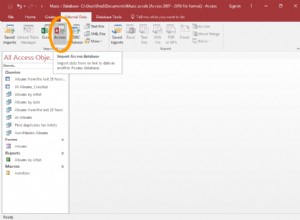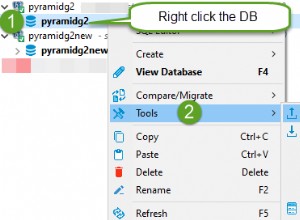In SQL Server il sp_server_info stored procedure di sistema restituisce un elenco di nomi di attributi e valori corrispondenti per SQL Server, il gateway del database o l'origine dati sottostante. Restituisce un sottoinsieme delle informazioni fornite da SQLGetInfo in ODBC.
Fondamentalmente, ti consente di visualizzare informazioni su SQL Server.
Sintassi
La sintassi è questa:
sp_server_info [[@attribute_id = ] 'attribute_id']
Il @attribute_id (opzionale). argomento ti consente di restringere i risultati a un solo attributo specifico.
Esempio 1 – Restituisci tutti gli attributi
In questo esempio, eseguo la stored procedure senza passare alcun argomento.
EXEC sp_server_info;
Può anche essere eseguito in questo modo:
sp_server_info;
Ecco il risultato sulla mia istanza di SQL Server 2019:
+----------------+------------------------+---------------------------------------------------------------------+ | attribute_id | attribute_name | attribute_value | |----------------+------------------------+---------------------------------------------------------------------| | 1 | DBMS_NAME | Microsoft SQL Server | | 2 | DBMS_VER | Microsoft SQL Server 2019 - 15.0.1800.32 | | 10 | OWNER_TERM | owner | | 11 | TABLE_TERM | table | | 12 | MAX_OWNER_NAME_LENGTH | 128 | | 13 | TABLE_LENGTH | 128 | | 14 | MAX_QUAL_LENGTH | 128 | | 15 | COLUMN_LENGTH | 128 | | 16 | IDENTIFIER_CASE | MIXED | | 17 | TX_ISOLATION | 2 | | 18 | COLLATION_SEQ | charset=iso_1 sort_order=nocase_iso charset_num=1 sort_order_num=52 | | 19 | SAVEPOINT_SUPPORT | Y | | 20 | MULTI_RESULT_SETS | Y | | 22 | ACCESSIBLE_TABLES | Y | | 100 | USERID_LENGTH | 128 | | 101 | QUALIFIER_TERM | database | | 102 | NAMED_TRANSACTIONS | Y | | 103 | SPROC_AS_LANGUAGE | Y | | 104 | ACCESSIBLE_SPROC | Y | | 105 | MAX_INDEX_COLS | 16 | | 106 | RENAME_TABLE | Y | | 107 | RENAME_COLUMN | Y | | 108 | DROP_COLUMN | Y | | 109 | INCREASE_COLUMN_LENGTH | Y | | 110 | DDL_IN_TRANSACTION | Y | | 111 | DESCENDING_INDEXES | Y | | 112 | SP_RENAME | Y | | 113 | REMOTE_SPROC | Y | | 500 | SYS_SPROC_VERSION | 15.00.1800 | +----------------+------------------------+---------------------------------------------------------------------+
Esempio 2:specificare un attributo
Se sei interessato a un solo attributo, puoi passare l'ID di quell'attributo. In questo modo viene restituita solo la riga di quell'attributo.
EXEC sp_server_info 500;
Può anche essere fatto in questo modo:
sp_server_info 500; sp_server_info @attribute_id = 500; EXEC sp_server_info @attribute_id = 500;
Risultato:
+----------------+-------------------+-------------------+ | attribute_id | attribute_name | attribute_value | |----------------+-------------------+-------------------| | 500 | SYS_SPROC_VERSION | 15.00.1800 | +----------------+-------------------+-------------------+
In questo esempio, restituisco l'attributo numero 500, che specifica la versione delle stored procedure del catalogo attualmente implementate.
Esempio 3:eseguire sp_server_info su un server collegato
In questo esempio, eseguo sp_server_info tramite una query pass-through su un server collegato chiamato Homer.
SELECT * FROM OPENQUERY( Homer, 'EXEC sp_server_info 500' );
Risultato:
+----------------+-------------------+-------------------+ | attribute_id | attribute_name | attribute_value | |----------------+-------------------+-------------------| | 500 | SYS_SPROC_VERSION | 14.00.3048 | +----------------+-------------------+-------------------+
Esempio 4:specificare quali colonne visualizzare
Un vantaggio collaterale di OPENQUERY() è che puoi ridurre le colonne restituite dalla stored procedure.
Esempio:
SELECT attribute_name, attribute_value FROM OPENQUERY( Homer, 'EXEC sp_server_info 500' );
Risultato:
+-------------------+-------------------+ | attribute_name | attribute_value | |-------------------+-------------------| | SYS_SPROC_VERSION | 14.00.3048 | +-------------------+-------------------+




